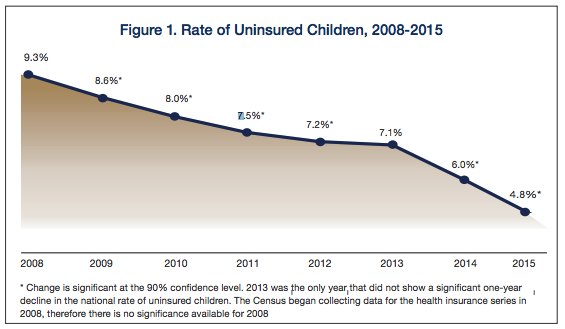Coverage success for children did not happen overnight and is not static. As we enter the next open enrollment period, we are reminded that coverage and maintaining coverage is ongoing and requires year-round support. This is especially true for children whose needs change as they grow and their opportunity for coverage changes with them.
 |
|
Photo Copyright: Georgetown University Health Policy Institute, Center for Children and Families |
Yesterday, Georgetown University Health Policy Institute’s Center for Children and Families celebrated health coverage gains for children around the country. The results of their report warrant celebration: 95% of children now have health care coverage with approximately 1.7 million children gaining coverage between 2013 and 2015. Since 2008, the number of uninsured children has been cut almost in half, reflecting the same period of time when the Children’s Health Insurance Program Reauthorization Act (CHIPRA) and the Affordable Care Act were enacted. This milestone is a direct reflection of national, state, and local advocacy working together to remove barriers for children to lead healthy, productive lives by providing them with the health coverage they need to succeed.
For New England, the results were particularly stunning. Thirty states now have rates of uninsured children lower than the national average, including all of New England except for Maine. Vermont and Massachusetts top the list of states with the lowest rates of uninsured children in 2015, respectively. The trends in Maine reflect the Governor Paul LePage’s broad opposition to the Affordable Care Act and Medicaid: He continually supports cuts in Medicaid – most notably, dropping 28,500 parents from Medicaid in 2013 and 2014 prior to ACA rollout.
For the states with coverage improvement for children, parent uninsured rates have also declined significantly since enactment of the ACA. This data reflects that extending parents coverage results in more children obtaining coverage, as well. And research tells us that when parents are covered, children are more likely to have coverage
Children need continued access to health care coverage in order to perform well in school, stay on track developmentally, remain healthy, and get treatment for medical needs. Research shows that children with Medicaid coverage are less likely to drop out of high school and more likely to graduate from college – covered children grow up to be healthier and more financially secure adults. It is clear that investing in children’s health is an investment in our communities’ economic growth and future.
There is still much work to be done. Half of all remaining uninsured children in the United States live in the South, and a disproportionate number of uninsured are older children and Hispanic children. With these gains and challenges, there still remains a risk to children without continued strengthening of the Affordable Care Act, CHIP and Medicaid. Coverage for children and families results in greater access to care and positive health outcomes, reinforcing the need for advocacy to call on continued efforts to close the coverage gap.
